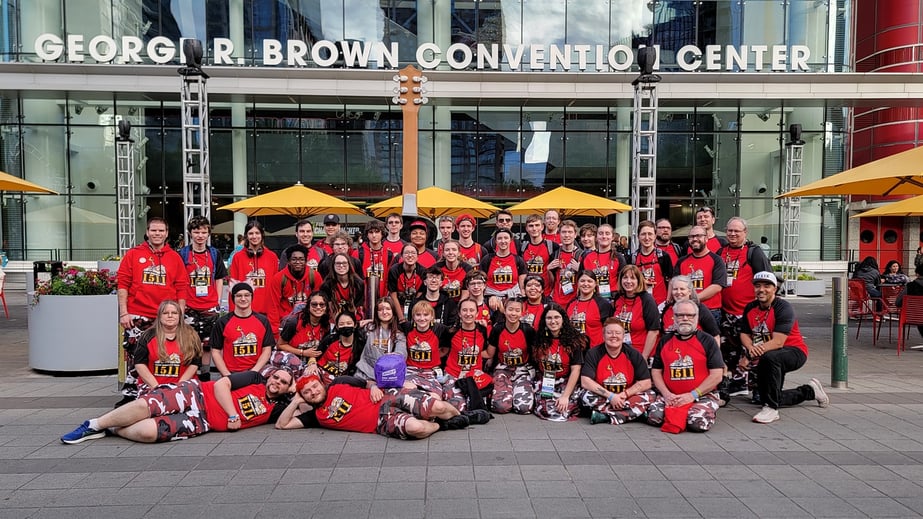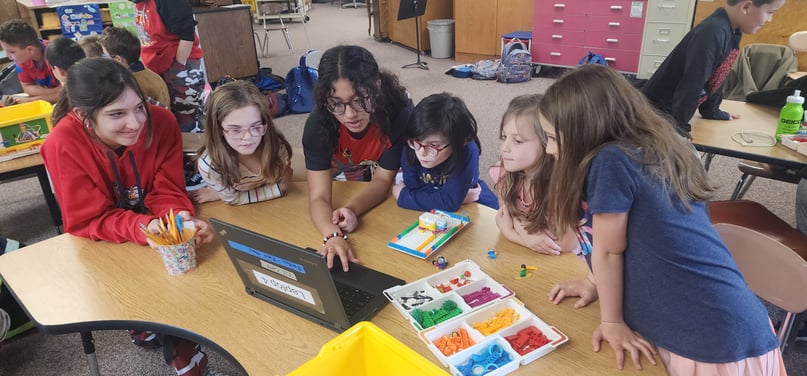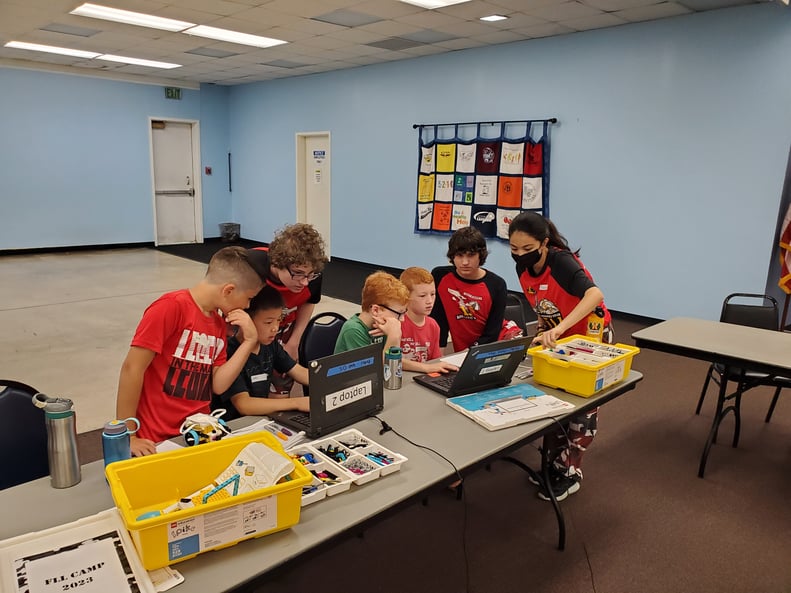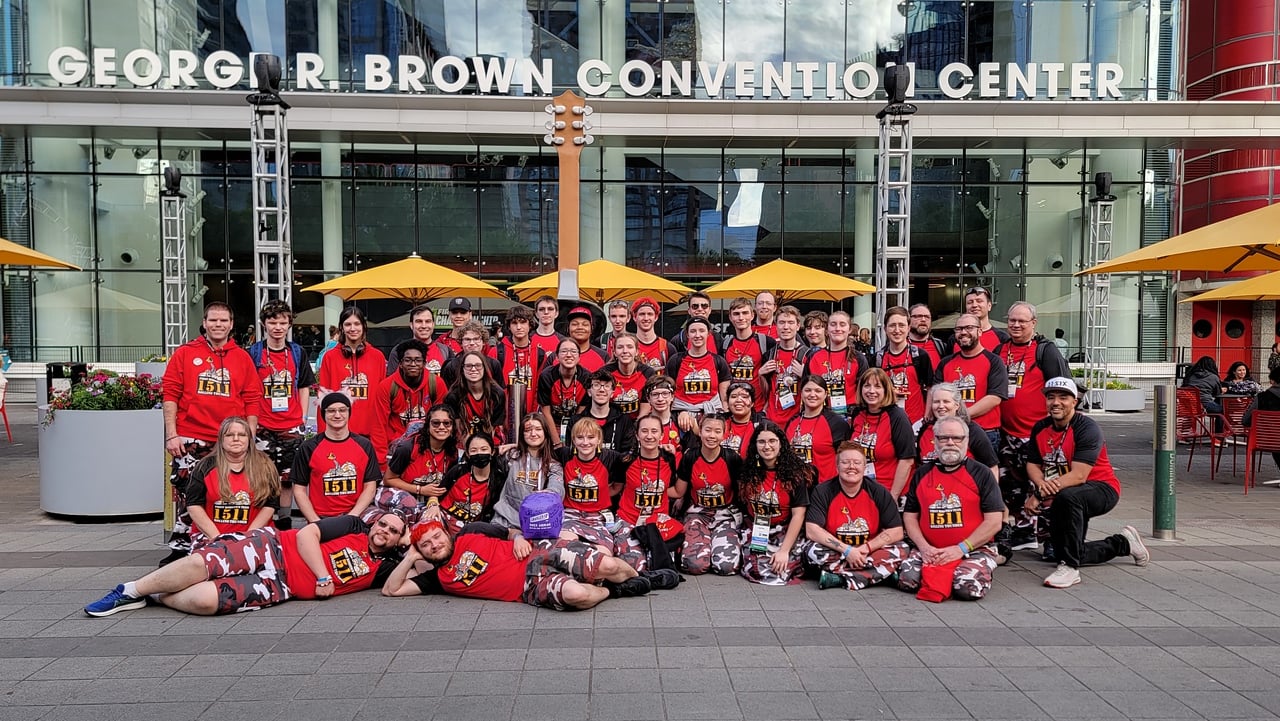By FIRST® Robotics Competition Team 1511 “Rolling Thunder”
In this guest blog from FIRST Robotics Competition Team 1511 “Rolling Thunder,” you’ll find a guide that outlines how to connect with your community through impactful outreach that will in turn help sustain your team.

Student Engagement is Key to Successful Outreach Initiatives
On 1511, we create an environment that fosters students to share their ideas and use personal connections to make an impact. Whether the idea is about our robot, our team, or potential outreach endeavors; we make sure that every student’s voice can be heard and considered.
Sometimes students are already engaged with a community service project, and we invite them to tell us more about it and determine if it aligns with our team’s goals and the FIRST mission. These ideas can be a project, supporting an event with a robot demonstration or taking up a collection. For example, we had several team members stay at the Ronald McDonald House and wanted to give back. We did this in several different ways: the House was our beneficiary of 1511’s Grateful Red Music Festival, members of the team volunteered for their fundraising garage sale and collected pop tabs during build season to help them raise money.
When we talk about student-driven outreach, it involves students taking on a leadership role, with mentors guiding them through. Students brainstorm ideas that help create new initiatives or improve existing ones. Students will lead these events and are also responsible for the planning and organization. Every outreach project on 1511 has a student lead. The student lead can reach out to our outreach subteam, subteam coordinator, or our subteam mentor for help at any time.
Foster an Environment that Values Outreach
Over the years, we have continually helped our team recognize the importance of outreach. We know that the more students we have involved in our outreach program, the more successful we can be at spreading FIRST and STEAM to our community.
Since we have team members without consistent transportation available to them, we always hold our outreach subteam meetings directly after school. All our students are encouraged to come to our meetings, and we also invite students from the whole school to check out what we do. During our meetings, we have open discussion time where we collect ideas from everybody who wishes to share, and as a group we build upon those ideas and turn it into a full-fledged outreach event.

Form Community Partnerships
Build relationships with your community through these five steps:
- Identify who you would like to work with. When you reach out, make sure you introduce your team, what you are looking to do with the organization whether it is a robot demonstration, a collection drive, or another event. Plan and conduct your outreach event. Treat it as if it is a professional experience. Make sure that all student volunteers have some knowledge of the organization you are working with. Lastly, the most important part of forming a partnership is thanking them and asking for feedback. In that feedback process, the organization can either extend an invite to return or you can ask.
- Once the relationship is formed you can acknowledge them on social media, invite them to your events, and send them updates on your team.
- Maintain the relationship. We hold a lot of programs with our local library. When they ask us to volunteer and help set up their book sale. We say yes because it’s an opportunity to help someone that we work with on a regular basis.
- As certain outreach events continue, student leads introduce themselves to the organization, so we do not lose contact. We also keep a spreadsheet tracking each outreach event and contact person.
- Do not be afraid to use your social media to help maintain relationships too. We often see ourselves on our partners social media. Tag them in outreach events you do as well.
Sustaining Outreach Events
One of the main things that we do on 1511 is writing Standard Operating Procedures, or SOPs. In a SOP, you describe the event step-by-step; you share what you did to ensure that the event ran smoothly, which includes what materials were used, what was done during the event, and how it was planned. These are especially helpful when you have a student who may be leading an event for the first time, as this takes some of the stress off them, allowing them to feel confident and excited, which leads to a more engaging and successful event! In addition, transferring ideas and knowledge from returning students to new ones is a crucial step. This ensures that no information is lost when the next students come up, allowing them to continue the work. On top of that, introducing the student leads to the various people that we work with keeps everyone on the same page, so that we minimize continuity issues.
Improving Outreach Events
There’s always room for improvement in outreach! After each program, making a collaborative effort to list all the positives and negatives from the event is a wonderful way to identify what activities can be tweaked to enhance the participants’ overall experience. As mentioned earlier, it is important to ask for feedback on your activities from the participants, and from the organization who you worked with. The feedback you receive can be added into the event’s SOP to further develop the program and ensure that any efforts to “build a better event” are incorporated.

Five Ways to Generate Initiatives
Generating outreach initiatives can be challenging, especially when you are starting out, so we have collected some tips to help you out!
- Get your team together and brainstorm! No idea is a bad one, and even ideas unrealistic for your team can be built on and turned into something wonderful you can achieve.
- Reach out to your local organizations and see if they are interested in collaborating for an event. We have done this in the past with Children Awaiting Parents, which is a local foster organization and others, and have received sustained programs through these partnerships.
- Look at what your community needs most! When we started our outreach, we looked at our community wish book, a guide of needs that local organizations put together, and determined how we can help.
- Don’t be afraid to work with your school district! I know a lot of teams want to spread FIRST as far as possible, but there are so many eager students in all districts ready to learn about STEAM. We run demos at our elementary school’s STEAM nights, end of the year carnivals, homecoming games, and more! Some of the best connections we have formed with kids have come through these events: meeting the kids at a demo, helping them join a FIRST LEGO League team, then getting to mentor them!
- Keep it simple and make STEAM kits to give out to your community! In the past, we have made our STEAM kits inclusive and engaging with as little as a piece of paper, a straw, and a string or as much as an entire catapult system of popsicle sticks. We usually give our STEAM kits out in tandem with other drives, like a sock donation to a local low-income housing area or local youth organization.
Example Outreach Event: Books & Bots Another outreach event we want to highlight is our Books and Bots program. Books and Bots started off a student personal passion project on 1511 and has grown into a flourishing community event since. When we first got the idea to bring a robotics program to our local library, it was brought up at an outreach subteam meeting and was met with support from the other students and mentors. Our lead mentor helped us make initial contact with the library and opened a stream of communication that we used to plan out the event details. When we got to the library, we were greeted by so many smiling faces excited to help us bring our love of FIRST and STEAM to these kids the library organized. We started off the day by playing a little game, then we read the book “Rosie Revere: Engineer” by Andrea Beaty. The kids all loved the story and got so excited to play catch with the robot. We even brought kids behind the driver station to drive the robot on their own with guidance from our students. We finished off by helping the students make their very own STEAM craft and talking about what robots they would want to make.
After the event, the library reached out to us to let us know that they, because our first event had such an impact on the kids, had bought Ozobots, little marker-programmable robots, and wanted us to run another event. We immediately agreed and held our second Books and Bots, this time teaching kids how to program Ozobots in lieu of our STEAM craft. Yet again, the kids loved the program, and we had parents reach out to our team afterwards asking what other events they could bring their children to!
After we had gained confidence in running our Books & Bots program in our library over the past few years, the outreach subteam reached out to one of our local Barnes & Noble bookstores to see if they would be interested in letting us run an event in their kids’ area. They said yes, and we were able to run a really successful Books & Bots program there! The staff were incredibly supportive – especially the store’s manager – and they even asked if we would come back to do more with them, which resulted in a joint fundraiser opportunity! Once again, it never hurts to ask – the worst that can happen is them telling you “no” – and if they say yes, it can open up lots of new opportunities!
Here is a QR code up there that links to a PDF of our Books & Bots SOP – feel free to scan it and use it as a model for your own events if you would like to!

If you have any questions about outreach, please contact the Rolling Thunder team here.
You can also follow them on social media:
Instagram: https://www.instagram.com/firstteam1511
Threads: https://www.threads.net/@firstteam1511
Facebook: https://www.facebook.com/penfieldrobotics/
Twitter: https://twitter.com/1511
